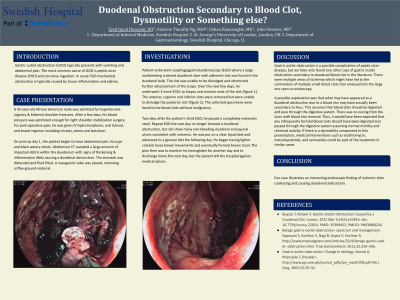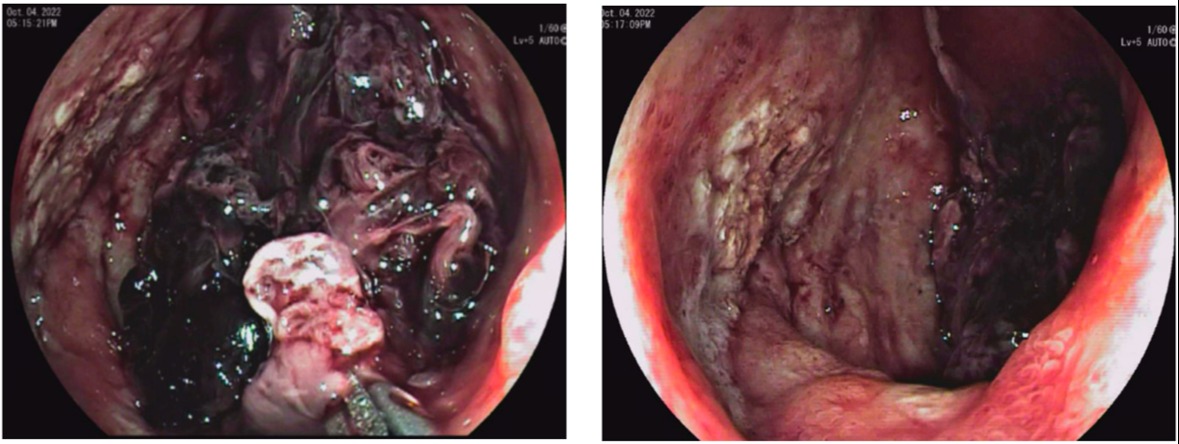Monday Poster Session
Category: Stomach
P2813 - Duodenal Obstruction Secondary to Blood Clot, Dysmotility or Something Else?
Monday, October 23, 2023
10:30 AM - 4:15 PM PT
Location: Exhibit Hall

Has Audio

Syed I. Hussaini, DO
Swedish Hospital, part of Northshore University Health System
Chicago, IL
Presenting Author(s)
Syed I. Hussaini, DO1, Andrew Timothy. Ng, MBBS2, Ushan A. Ranasinghe, MD, MS1, John Venetos, MD1
1Swedish Hospital, part of Northshore University Health System, Chicago, IL; 2St. George's University of London, Chicago, IL
Introduction: Gastric outlet obstruction (GOO) refers to a condition in which there is a blockage or narrowing at the outlet of the stomach, preventing the normal passage of food into the small intestine. It can lead to various symptoms and requires medical attention for diagnosis and treatment. Peptic ulcer disease (PUD) and corrosive ingestion are frequently identified as the primary etiologies for GOO. In this case, we will explore multiple contributing factors.
Case Description/Methods: A 42-year-old African American male was admitted for hypertensive urgency and bilateral shoulder fractures. After surgery and pain management, he developed abdominal pain, hiccups, and black watery stools. CT scan revealed duodenal obstruction with impacted debris. Nasogastric suctioning removed coffee-ground material. On esophagogastroduodenoscopy (EGD), a non-bleeding cratered duodenal ulcer with an adherent clot was identified in the duodenal bulb. Despite multiple attempts, the clot could not be dislodged, impeding further advancement of the scope. Over the following days, two additional EGD procedures were performed to biopsy and remove most of the clot, however the posterior portion remained. The collected specimens were determined to be blood clots without any signs of malignancy. The patient passed a melanotic stool and on final EGD had several duodenal and jejunal non-bleeding ulcers consistent with ischemia. Diet was adjusted, and bowel movements improved. However, the patient left the hospital against medical advice before discharge was considered.
Discussion: Gastric outlet obstruction can occur as a complication of PUD. However, we have only encountered one other documented case in the literature of GOO caused by a duodenal blood clot. One possible explanation is that what appeared as a duodenal obstruction due to a blood clot might actually have been attributable to ileus. This assumption is based on the notion that blood clots should be naturally broken down and passed through the digestive system. The absence of oozing from the ulcer during the removal of the blood clot supports this notion. Consequently, it would have been anticipated that infrequently formed blood clots would undergo digestion and normal passage through the digestive system, assuming adequate motility and chemical activity. In cases with a dysmotility component similar to this presentation, medical interventions such as erythromycin, metoclopramide, and sennosides could be considered as part of the treatment strategy.

Disclosures:
Syed I. Hussaini, DO1, Andrew Timothy. Ng, MBBS2, Ushan A. Ranasinghe, MD, MS1, John Venetos, MD1. P2813 - Duodenal Obstruction Secondary to Blood Clot, Dysmotility or Something Else?, ACG 2023 Annual Scientific Meeting Abstracts. Vancouver, BC, Canada: American College of Gastroenterology.
1Swedish Hospital, part of Northshore University Health System, Chicago, IL; 2St. George's University of London, Chicago, IL
Introduction: Gastric outlet obstruction (GOO) refers to a condition in which there is a blockage or narrowing at the outlet of the stomach, preventing the normal passage of food into the small intestine. It can lead to various symptoms and requires medical attention for diagnosis and treatment. Peptic ulcer disease (PUD) and corrosive ingestion are frequently identified as the primary etiologies for GOO. In this case, we will explore multiple contributing factors.
Case Description/Methods: A 42-year-old African American male was admitted for hypertensive urgency and bilateral shoulder fractures. After surgery and pain management, he developed abdominal pain, hiccups, and black watery stools. CT scan revealed duodenal obstruction with impacted debris. Nasogastric suctioning removed coffee-ground material. On esophagogastroduodenoscopy (EGD), a non-bleeding cratered duodenal ulcer with an adherent clot was identified in the duodenal bulb. Despite multiple attempts, the clot could not be dislodged, impeding further advancement of the scope. Over the following days, two additional EGD procedures were performed to biopsy and remove most of the clot, however the posterior portion remained. The collected specimens were determined to be blood clots without any signs of malignancy. The patient passed a melanotic stool and on final EGD had several duodenal and jejunal non-bleeding ulcers consistent with ischemia. Diet was adjusted, and bowel movements improved. However, the patient left the hospital against medical advice before discharge was considered.
Discussion: Gastric outlet obstruction can occur as a complication of PUD. However, we have only encountered one other documented case in the literature of GOO caused by a duodenal blood clot. One possible explanation is that what appeared as a duodenal obstruction due to a blood clot might actually have been attributable to ileus. This assumption is based on the notion that blood clots should be naturally broken down and passed through the digestive system. The absence of oozing from the ulcer during the removal of the blood clot supports this notion. Consequently, it would have been anticipated that infrequently formed blood clots would undergo digestion and normal passage through the digestive system, assuming adequate motility and chemical activity. In cases with a dysmotility component similar to this presentation, medical interventions such as erythromycin, metoclopramide, and sennosides could be considered as part of the treatment strategy.

Figure: Figure on left is the initial encountered blood clot before endoscopic piecemeal removal. Figure on right is after removal of majority of blood clot revealing ischemic ulcers.
Disclosures:
Syed Hussaini indicated no relevant financial relationships.
Andrew Ng indicated no relevant financial relationships.
Ushan Ranasinghe indicated no relevant financial relationships.
John Venetos indicated no relevant financial relationships.
Syed I. Hussaini, DO1, Andrew Timothy. Ng, MBBS2, Ushan A. Ranasinghe, MD, MS1, John Venetos, MD1. P2813 - Duodenal Obstruction Secondary to Blood Clot, Dysmotility or Something Else?, ACG 2023 Annual Scientific Meeting Abstracts. Vancouver, BC, Canada: American College of Gastroenterology.
